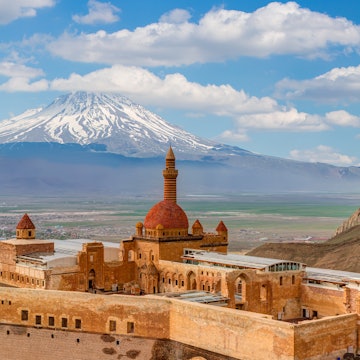
Sample Nanjing's signature dishes – they’re some of Chinese cuisine’s best
Sponsored by

Mar 7, 2022 • 5 min read

©PixHound/Shutterstock
The city of Nanjing – China’s old capital – is the home to Jinling cuisine. It’s not totally clear when Jinling cuisine first appeared, though some think it may have been as early as 2,400 years ago. Regardless, the sub-cuisine has had plenty of time to evolve, and Nanjing’s regal history has made it a leading culinary city in China today.
To this day, Nanjing’s food scene remains undoubtedly rich. Read on to discover the pillars of Nanjing’s diverse cookbook and key dishes worthy of trying – some ancient, others newer.

In Nanjing, fish and crustaceans reign
Two major rivers flow through the city, the Yangtze and the Qinhuai, serving Nanjing’s major lakes. Thanks to these waterways, residents can enjoy a plethora of fish and crustaceans, which make up a vast number of Nanjing’s signature dishes.
‘Hairy crabs,’ which are given the name due to their humorously hairy claws, are found in the south of Nanjing. The succulent, buttery, esteemed crustaceans are predominantly bred in the Gaochun district and are sought after by cities all around the country. Hairy crabs are commonly steamed and enjoyed with vinegar and ginger sauce.
When it’s not hairy crab season, sweet and sour fish is a must-try staple. It’s an absolute crowd-pleaser that is customarily shared with family and friends. A whole fish is elaborately cut to resemble a squirrel’s tail; it’s then floured and fried until crispy and finished with a red-orange sauce that combines sugar and vinegar. When it lands on the table, it’s often a showstopper.

A city fond of duck
Nanjing is sometimes referred to as the ‘city of duck’ due to its sheer number of duck dishes, one of its most renowned being salted duck. Duck is boiled in water flavored with a bouquet of aromatics such as star anise, cinnamon, scallions, and ginger. The duck is left to cool entirely before being sliced and served. Fragrant and tender, this one often graces the tables of diners at traditional restaurants in Nanjing.
Duck blood soup is an iconic Nanjing delicacy, and it makes use of the rest of the duck after the actual meat is removed. Slices of cooked, jelly-like duck blood – a popular ingredient in Chinese medicine due to its nutritional properties – are combined with liver, gizzard, and intestine. Rice noodles round out the dish, which is finished with the toppings such as sesame oil and chili oil.

Jinling duck actually came before Peking duck. One legend states that when Ming dynasty emperor Zhu Di moved from Nanjing to Beijing, he took the palace’s duck chefs with him, as he was fond of the style of duck they specialized in. Jinling duck is roasted so that the meat is tender and the skin is both crispy and satisfyingly greasy. Thin pieces of masterfully cut duck are enjoyed with a dipping of plum sauce.
Delectable dumplings
Dumplings are the chameleon of dishes. Whether they’re eaten for breakfast with some tea, as part of a larger lunch feast, or with some beer at dinner, dumplings can be enjoyed on countless occasions. Nanjing’s love for dumplings extends to all styles, but there are a few dumpling varieties in particular that the city is known for.
Pan-fried beef dumplings or ‘pot-sticker’ dumplings are greatly loved. A mixture of minced beef, ginger, and spring onion is encased with pastry, then fried so that they’re soft on top and crispy on the bottom. Sugar and soy in the dumpling filling provide sweetness and saltiness, a common flavor pairing in much of Nanjing’s food. Pan-fried beef dumplings are often enjoyed with beef soup, known as niurou tang.

Those eating soup dumplings for the first time might want to ask for a ‘how to eat’ tutorial. But, once diners master the method, soup dumplings are one of the best dishes Nanjing has to offer. Inside the thin, steamed dumpling pastry is a meatball, commonly made of pork, chicken, prawn, crab, or sometimes a combination of two. They’re also filled with soup flavored with the same protein. To eat, gently pierce a small hole in the top of the dumpling and allow it to cool slightly before slurping out some of the soup. Then proceed to enjoy the rest of the dumpling! Patience is key – otherwise, diners run the risk of burning themselves on steaming hot broth.

Shaomai are another steamed treasure but are more commonly enjoyed at breakfast. These little parcels of dumpling art are made of flaky pastry that can contain a variety of fillings, such as glutinous rice, meat, mushrooms, and more. Unlike other dumplings, shaomai are distinctive as their pastry doesn’t cover the entirety of the dumpling’s contents; a little bit of the filling cheekily peeps out at the top, teasing those about to delve in.
Beyond Jinling cuisine
Nanjing is considered a melting pot due to its extensive history, old capital status, and accessible geographical location. It’s a city with a significant migrant population, who have shared their own cuisines as they have settled. As such, it’s not only the tastes of Jinling cuisine that people can enjoy when visiting the city but tastes from other provinces, cities, and towns all around China. Some prevalent cuisines to enjoy once visitors have had their fill of Nanjing’s specialties are those from Sichuan, Guangdong, Shandong, and Yunnan. Sampling dishes from other regions allows visitors to taste the similarities, differences, and unique influences both on and from the rest of China.
Sponsored by Nanjing Municipal Bureau of Culture and Tourism
As a travel entertainment and inspirational media outlet, we sometimes incorporate brand sponsors into our efforts. This activity is clearly labeled across our platforms.
This story was crafted collaboratively between Nanjing Municipal Bureau of Culture and Tourism and Lonely Planet. Both parties provided research and curated content to produce this story. We disclose when information isn’t ours.
With sponsored content, both Lonely Planet and our brand partners have specific responsibilities:
-
Brand partner
Determines the concept, provides briefing, research material, and may provide feedback.
-
Lonely Planet
We provide expertise, firsthand insights, and verify with third-party sources when needed.












